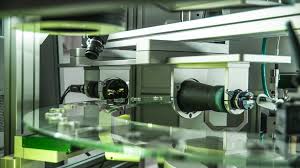In the fast-paced world of modern manufacturing, quality control has never been more critical. As consumer expectations rise and competition intensifies, manufacturers are turning to cutting-edge technologies to ensure their products meet the highest standards. At the forefront of this revolution is the AI-powered machine vision system, a technology that’s redefining what’s possible in quality control. This article explores how AI machine vision is transforming quality assurance processes, offering unprecedented accuracy, efficiency, and consistency.
The Evolution of Quality Control
Traditionally, quality control relied heavily on human inspectors or basic automated systems. While these methods have served industries well for decades, they come with inherent limitations. Human inspectors, no matter how skilled, are susceptible to fatigue, inconsistency, and the inability to detect minute defects consistently. Basic automated systems, while more consistent, lack the flexibility to adapt to new products or subtle variations in defects.
Enter AI machine vision. This technology combines high-resolution cameras with sophisticated artificial intelligence algorithms, creating a powerful tool that can see and analyze products with superhuman accuracy and speed. Unlike its predecessors, AI machine vision systems can learn, adapt, and improve over time, making them ideal for the dynamic nature of modern manufacturing.
The Power of AI in Visual Inspection
At the heart of AI machine vision’s effectiveness in quality control is its ability to process and analyze visual data in ways that far surpass human capabilities. These systems can:
- Detect Microscopic Defects: AI-powered cameras can zoom in on the tiniest details, identifying flaws invisible to the naked eye. This is particularly crucial in industries like electronics or medical device manufacturing, where even the smallest imperfection can have significant consequences.
- Analyze Complex Patterns: Advanced algorithms can recognize and analyze complex patterns and textures, making them adept at inspecting products with intricate designs or variable surfaces.
- Maintain Consistency: Unlike human inspectors who may become fatigued or distracted, AI systems maintain the same level of scrutiny throughout long production runs, ensuring consistent quality standards.
- Learn and Adapt: Perhaps most importantly, AI machine vision systems can learn from new data, continuously improving their accuracy and adapting to new product variations or types of defects.
Real-World Applications
The applications of AI machine vision in quality control are vast and growing. Here are some key areas where this technology is making a significant impact:
- Automotive Manufacturing: In car production, AI machine vision systems inspect everything from paint quality to the proper assembly of complex components. They can detect misalignments, improper welds, or paint defects with incredible accuracy.
- Food and Beverage Industry: AI vision ensures that products are properly sealed, labeled, and free from contamination. It can detect foreign objects, assess freshness, and verify proper packaging in high-speed production lines.
- Electronics Manufacturing: In the production of smartphones, computers, and other electronic devices, AI vision systems inspect solder joints, component placement, and surface defects at a microscopic level.
- Pharmaceutical Production: Ensuring the quality and safety of medications is critical. AI vision systems verify proper pill count, inspect for broken tablets, and ensure accurate labeling.
- Textile Industry: AI vision can inspect fabric for weaving errors, color inconsistencies, or other defects at speeds impossible for human inspectors.
Benefits Beyond Defect Detection
While identifying defects is a primary function of AI machine vision in quality control, the benefits extend far beyond this:
- Data-Driven Insights: These systems collect vast amounts of data, which can be analyzed to identify trends, predict potential issues, and optimize production processes.
- Reduced Waste: By catching defects early in the production process, manufacturers can reduce waste and improve overall efficiency.
- Increased Production Speed: AI vision systems can inspect products at high speeds without sacrificing accuracy, allowing for increased production rates.
- Enhanced Traceability: Every inspection can be logged and tracked, providing a comprehensive record for regulatory compliance and continuous improvement efforts.
- Flexibility: Unlike traditional automated systems, AI vision can be quickly retrained for new products or variations, making it ideal for manufacturers with diverse product lines.
Overcoming Implementation Challenges
While the benefits of AI machine vision in quality control are clear, implementing these systems does come with challenges:
- Data Requirements: AI systems require large amounts of data to train effectively. Manufacturers need to have a strategy for collecting and managing this data.
- Workforce Adaptation: Employees need to be trained to work alongside these new systems, which may require new skills and a shift in job responsibilities.
- Continuous Maintenance and Updating: To maintain peak performance, AI vision systems require ongoing maintenance, updates, and retraining as products or production processes change.
The Future of AI Machine Vision in Quality Control
As AI technology continues to advance, we can expect to see even more sophisticated applications in quality control:
- Predictive Quality Assurance: AI systems will not only detect defects but predict where and when they’re likely to occur, allowing for preemptive action.
- Enhanced 3D Inspection: Improvements in 3D imaging and AI will allow for more comprehensive inspection of complex, three-dimensional objects.
- Integration with Robotics: AI vision systems will work in tandem with robotic systems to not only detect but also correct defects in real-time.
- Expanded Use of Deep Learning: More advanced deep learning algorithms will allow for even greater accuracy and the ability to detect increasingly subtle defects.
- Edge Computing Integration: By processing data closer to the source, edge computing will enable faster, more efficient AI vision systems.
Ethical Considerations and Best Practices
As with any advanced technology, the use of AI in quality control raises important ethical considerations:
- Data Privacy: Manufacturers must ensure that any data collected by AI vision systems is handled securely and in compliance with relevant regulations.
- Transparency: It’s important to maintain transparency about how AI systems make decisions, especially in industries where quality control has safety implications.
- Human Oversight: While AI can greatly enhance quality control, human oversight remains crucial. Manufacturers should strive for a balance between AI capabilities and human expertise.
- Continuous Evaluation: Regular audits of AI vision systems should be conducted to ensure they continue to meet quality standards and don’t develop unintended biases.
AI machine vision is revolutionizing quality control in manufacturing, offering unprecedented accuracy, efficiency, and consistency. By detecting defects invisible to the human eye, maintaining unwavering focus over long production runs, and continuously learning and adapting, these systems are helping manufacturers produce higher quality products with less waste and greater efficiency.
While the implementation of AI vision systems comes with challenges, the benefits far outweigh the hurdles for many manufacturers. As the technology continues to evolve, we can expect to see even more sophisticated applications that not only detect defects but predict and prevent them.
In an era where quality can make or break a company’s reputation, AI machine vision is proving to be an invaluable tool. It’s not just improving quality control; it’s redefining what’s possible in manufacturing excellence. As we look to the future, it’s clear that AI machine vision will play an increasingly crucial role in ensuring that the products we use every day meet the highest standards of quality and reliability.



